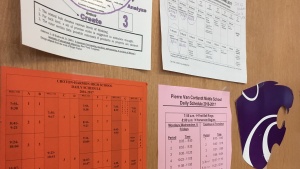By Tonnie Martinez
It’s always fun for K-State faculty to visit schools. We love it when research or student teacher support takes us into a building. One of the buildings I get the privilege of visiting is Apache Innovative School in the Shawnee Mission School District. I’d like to invite EdCats to come with me as I relive recent visits to Apache IS.
We’ll start just outside the office area where some creative students have taken the lost and found pile and turned it into “The Lost and Found Boutique,” fashionably styling forgotten garments on dress forms for owner rescue.
It’s not unusual for a random student to greet a visitor. Yesterday Student A changed direction, made eye contact, shook my hand, and after introducing himself asked, “What is the nature of your business at Apache today?” After some small talk he questioned, “Was teaching your first career choice?” This brief exchange is a common-place example of why this building is a special place.
The Building: From magnetic walls that allow a student to stop and “spell” the roses on the way to the restroom, to flexible seating options that include KC Chiefs lawn chairs and stacked gymnasium mats; students at Apache have seating choices to match how they learn best (which may change throughout the day). Strategically placed collaboration spaces can be found in every available nook and cranny, often being used for one-to-one or small group skills practice.
The Learner and Learning: Data drives every instructional decision made in this building. Period. Instructional coaches drill down to the even the smallest data or biographical detail that may be leveraged to make a difference in a child’s individual learning plan. A student just learned to ride a bike? It’s highly likely the teacher will know and use that information. Learning math is more fun when a student realizes how many times they pedal in 30 seconds can be their math problem. Oh, and if a student doesn’t have a bike or know how to ride? A local bike shop brings a trailer full of bikes to get that riding instruction covered during recess or PE.
Content Knowledge: Every student is on an individualized learning journey. Students are in both horizontal and vertical looping structures. That means that they may loop from first to to second grade with the same teacher. (Think of all the time saved when the teacher already knows a students’ backgrounds and biography). Vertical looping means a student may learn math content with the same teacher in first, third, and fifth grade, allowing for building students’ content knowledge with strategically sequenced curriculum and grade level milestones along the way.
Application of Content: Just the other day, Apache students had a “Student’s Choice Day” in which teachers provided highly engaging activities (e.g., pumpkin carving geometry and seed estimation). Students chose which activities to visit, probably not realizing they had been carefully constructed to meet necessary state standards and student learning outcomes. Community members have been tapped to interview students to increase career awareness and soft skills practice during project-based learning units. Imagine a parent using a sewing machine from the Maker space to hem a pair of their student’s jeans on family math night using 10 stitches per inch. Innovative ideas for family math and reading are possible (and encouraged) at Apache.
Instructional Practice: Teachers collaborate daily. I walked into a conference room to check my messages and heard a conversation that focused on deep analysis of data, and the teachers quizzed each other for “one more intervention strategy” to increase two students’ letter recognition–students that were below grade level when they enrolled.
Students Are Part of a Learning Community Across Grade Levels: I found myself smiling when a fifth-grader came into a second-grade math classroom, found his former teacher, and hugged her. He had finished the math lesson in his classroom and came to help. She handed him a stack of flash cards and said, “You are just in time! Student B would love you to help him practice!” As I left the classroom, the teacher was having students build math equation models with Legos and write their answers on table tops with dry erase markers (Yes, students can write on the furniture!). I quietly shut the door as I heard the fifth grade student–now in the hall with his learning buddy–exclaim, “Hey, you are really getting the hang of this!”
The administration, instructional coaches and staff at Apache work tirelessly to ensure that ALL students learn. I have never seen a school culture quite like it. Two hours after the bell rang, I packed up and left a meeting with student teachers. I noticed a student teacher walked back into her classroom to cheering and clapping. Not able to resist, I poked my head in to see what the commotion was. “Look, look!” the collaborators exclaimed, “Our sight word booklets came back from the copy center! We can’t wait to give them out tomorrow!” No doubt the students were as excited; the teachers were enthusiastically planning the next days’ sight word launch as I slipped back out of the classroom.
Is it perfect? No. The deck is stacked against Apache. In the midst of all of the excitement and wonder, too many students struggle with imperfect childhoods, unfair poverty, and food security issues that impact learning. State assessment practices are not robust enough to demonstrate all the ways Apache IS students will be successful (eye contact, a firm handshake, and helping another practice a skill set you have mastered are important soft skills tied to career success but not state assessments). Critics quick to publicly denounce innovative practices would do well to visit. They would quickly discover the intangibles that make Apache IS a great place to learn academics and more. Or they could just ask Student C., who nearly ran over me on a bicycle as I visited with a teacher. Emerging from the orange cones as the bike shop volunteers let go of him, he screamed to all, “This is the best day of my life!”
You can share in the Apache Innovative School excitement by following these Twitter accounts: @ApacheIS512 (school) @principalplewis (admin) @brpumphrey (admin), @AbbyLeeMorgan (Instructional Coach).











 A K-State College of Education graduate, Meshell is a gifted facilitator for Manhattan-Ogden schools. She has worked in gifted education for the past 12 years. A mother of two children who attend Manhattan-Ogden schools, she is currently working on a graduate degree in Building Leadership in K-State’s College of Education.
A K-State College of Education graduate, Meshell is a gifted facilitator for Manhattan-Ogden schools. She has worked in gifted education for the past 12 years. A mother of two children who attend Manhattan-Ogden schools, she is currently working on a graduate degree in Building Leadership in K-State’s College of Education.